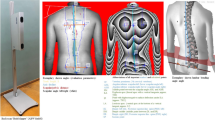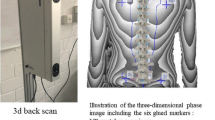Abstract
Analyzing standing posture requires a precise measure of the orientation of the various body segments with respect to the gravitational vector. We studied the posture variability of 34 healthy upright standing subjects. Using a force platform combined with a powerful stereoradiographic technique, we acquired the spine and pelvis three-dimensional (3D) geometry and located it with respect to the gravity line. For our data set, the mean 3D distance between the geometrical center of each vertebral body and the gravity line was 28 mm with a standard deviation of 5.6 mm. The vertebrae location variability, defined as plus or minus twice the mean standard deviation, was ±40 mm in the sagittal plane and ±25 mm in the frontal plane. The line connecting the middle of the external acoustic meatus (center of both acoustic meati: CAM) to the middle of the bi-coxo-femoral axis (hip axis: HA) was almost vertical. Its mean distance to the gravity line was 30 mm. Our data show a left lateralization, with respect to the gravity line, of the "Head-Spine-Pelvis" segments. The mean distance was 7.6 mm (SD 1.6 mm). This might be due to uneven partitioning of the body mass on each side of the sagittal plane.
Résumé
L'étude de la posture nécessite la détermination de l'orientation des différents segments du corps par rapport au vecteur de la gravité. Le but de cette étude était de caractériser de manière tridimensionnelle la variabilité du positionnement de sujets sains par rapport à la ligne de gravité lorsque ces sujets sont placés en station érigée. Pour cela nous avons utilisé de manière combinée une technique de stéréoradiographie et une plate-forme de force. Ce dispositif nous a permis d'acquérir de manière tridimensionnelle et chez des sujets en charge la géométrie du rachis et du pelvis, ainsi que la position de la ligne de gravité du corps entier. La ligne de gravité se situait en moyenne à une distance 3D de 28±5,6 mm des centres géométriques des corps vertébraux. La variabilité de positionnement des vertèbres dans le plan sagittal par rapport à la ligne de gravité était de l'ordre de ±4 cm, et de ±2,5 cm dans le plan frontal. L'axe "Centre des méats acoustiques externes (CAM)—Centre des têtes fémorales (HA)" était sensiblement vertical, mais situé en avant de la ligne de gravité à une distance moyenne de 30 mm. Il existait dans notre série une latéralisation à gauche de l'ensemble "Tête-Rachis-Pelvis" par rapport à la ligne de gravité avec une distance moyenne de 7,6±1,6 mm. L'explication proposée est l'absence de symétrie absolue de répartition de la masse corporelle de part et d'autre du plan sagittal (masse hépatique à droite).






Similar content being viewed by others
References
Abdel-Aziz YI, Karara HM (1971) Direct linear transformation from comparator coordinates into object space coordinates in close range photogrammetry. Proceedings of the ASP/UI Symposium on closerange photogrammetry, Urbana, Illinois
André B, Dansereau J, Labelle H (1992) Effect of radiographic landmark identification errors on the accuracy of three-dimensional reconstruction of the human spine. Med Biol Eng Comput 30: 569–575
Aubin C.E., Dansereau J, Parent F, Labelle H, de Guise JA (1997) Morphometric evaluations of personalized 3D reconstructions and geometric models of the human spine. Med Biol Eng Comput 35: 611–618
Basmajian JV, DeLuca DJ (1985) Muscles alive, 5th edn. Williams & Wilkins, Baltimore
Bernhardt M, Bridwell KH (1989) Segmental analysis of the sagittal plane alignment of the normal thoracic and lumbar spines and thoracolumbar junction. Spine 14: 717–721
Bonne AJ (1969) On the shape of the human vertebral column. Acta Orthop Belg 35: 567–583
Braune W, Fischer O (1985) On the center of gravity of the human body. Springer, Berlin Heidelberg New York
Champain N, Pomero V, Dubousset J, Skalli W (2001) Geometric and biomechanical postural characterisation of the human trunk. XVIIIth congress of the ISB, Zurich
Chen L, Armstrong CW, Raftopolous DD (1994) An investigation on the accuracy of the three-dimensional space reconstruction using the direct linear transformation. J Biomech 2: 493–500
Dumas R, Mitton D, Laporte S, Dubousset J, Steib JP, Lavaste F, Skalli W (2003) Explicit linear calibration for stereoradiography. J Biomech 36: 827–834
Dansereau J, Stokes IA (1988) Measurements of the three-dimensional shape of the rib cage. J Biomech 21: 893–901
During J, Goudfrooij H, Keessen W, Beeker THW, Crowe A (1985) Toward standards for postural characteristics of the lower back system in normal and pathologic conditions. Spine 10: 83–87
Duval-Beaupère G, Schimdt C, Cosson PH (1992) A barycentrometric study of the sagittal shape of spine and pelvis. Ann Biomed Eng 20: 451–462
Gelb DE, Lenke LG, Bridwell KH, Blanke KB, McEnery KW (1995) An analysis of sagittal spinal alignment in 100 asymptomatic middle and older aged volunteers. Spine 20: 1351–1358
Hatze H (1988) High-precision and three-dimensional photogrammetric calibration and object space reconstruction using a modified DLT-approach. J Biomech 21: 533–538
Itoi E (1991) Roentgenographic analysis of posture in spinal osteoporotics. Spine 16: 750–756
Jackson RP, Hales C (2000) Congruent spinopelvic alignment on standing lateral radiographs of adult volunteers. Spine 25: 2808–2815
Kendall FP (2001) Les muscles: bilan et étude fonctionnels. Pradel, Rueil-Malmaison, pp 69–110
Klausen K, Raussmussen B (1968) On location of the line of gravity in relation to L5 in standing. Acta Physiol Scand 72: 45–52
Legaye J, Duval-Beaupère G, Hecquet J, Marty C (1998) Pelvic incidence: a fundamental pelvic parameter for three-dimensional regulation of spinal sagittal curves. Eur Spine J 7: 99–103
Legaye J, Santin J.J, Hecquet J, Marty C, Duval-Beaupère G (1993) Bras de levier de la pesanteur supportée par les vertèbres lombaires. Rachis 1: 13–20
Marnay T (1988) L'équilibre du rachis et du bassin. Cahiers d'enseignement de la SOFCOT. Elsevier, Paris, pp 281–313
Marzan GT (1976) Rational design for close-range photogrammetry, PhD thesis, Department of CIVIL ENGINEERING, University of Illinois at Urbana-Champaign, USA
Mitton D, Landry C, Veron S, Skalli W, Lavaste F, De Guise JA (2000) 3D reconstruction method from biplanar radiography using non-stereocorresponding points and elastic deformable meshes. Med Biol Eng Comput 38: 133–139
Mitulescu A, Semaan I, De Guise JA, Leborgne P, Adamsbaum C, Skalli W (2001) Validation of non-stereocorresponding points stereoradiographic 3D reconstruction technique. Med Biol Eng Comput 39: 152–158
Mitulescu A, Skalli W, Mitton D, De Guise JA (2002) Three-dimensional surface rendering reconstruction of scoliotic vertebrae using a non-stereocorresponding points technique. Eur Spine J 11: 344–352
Pearcy MJ (1985) Stereoradiography of lumbar spine motion. Acta Orthop Scand 212: 1–45
Roussouly P, Assi C, Schiavi A, Vaz G, Dimnet J (1998) Critères sagittaux de la lombalgie. La chirurgie du rachis lombaire dégénératif. Sauramps, Montpellier, pp 146–153
Roussouly P, Mota H, Berthonaud E, Dimnet J (2001) Positionnement de l'axe de gravité global. XXXIInd congress of the GES, Nice
Sales de Gauzy J, Glorieux V, Dupui R, Montoya R, Fargues P, Cahuzac JP (2001) Evaluation posturographique de l'équilibre après chirurgie pour scoliose idiopathique. XXXIInd congress of the GES, Nice
Skalli W, Mitton D, Pomero V, Champain N, Lavaste F (2001) Equilibre sagittal, plate-forme de force, assistance par ordinateur. XXXIInd congress of the GES, Nice
Staffel F (1889) Die menschlichen Haltungstypen und ihre Beziehungen zu den Rückgratsverkrümmungen. Wiesbaden
Stagnara P, De Mauroy JC, Dran G, et al (1982) Reciprocal angulation of vertebral bodies in a sagittal plane: approach to references for the evaluation of kyphosis and lordosis. Spine 7: 335–342
VanRoyen BJ, Toussaint HM, Kingma I (1998) Accuracy of the sagittal vertical axis in a standing lateral radiograph as a measurement of balance in spinal deformities. Eur Spine J 7: 408–412
Vedantam R, Lenke LG, Bridwell KH, Linville DL, Blanke K (2000) The effect of variation in arm position on sagittal spinal alignment. Spine 25: 2204–2209
Véron S (1997) Modélisation géométrique et mécanique tridimensionnelle par éléments finis du rachis cervical supérieur. Doctoral thesis, ENSAM, Paris
Vital JM, Sénégas J (1986) Anatomical bases of the study of the constraints to which the cervical spine is subject in the sagittal plane. A study of the center of gravity of the head. Surg Radiol Anat 8: 169–173
Winter DA (1995) Human balance and posture control during standing and walking. Gait Posture 3: 193–214
Yoneyama Y (1988) A clinical study on lateral deviation of the line of gravity in idiopathic scoliosis. Nippon Seikeigeka Gakkai Zasshi 3: 151–160
Zatsiorsky VM, King DL (1998) An algorithm for determining gravity line location from posturographic recordings. J Biomech 31: 161–164
Acknowledgements
We wish to thank the whole team at the Paris ENSAM Laboratoire de Biomécanique, particularly V. Lafage, A. Mitulescu, S. Laporte, and N. Champain. We thank Prof. Dubousset at Saint Vincent de Paul hospital, Paris. We also thank the Service de Radiologie, Prof. Diard, Bordeaux CHU, and E. Jolivet for their help with data acquisition.
Author information
Authors and Affiliations
Corresponding author
Electronic Supplementary Material
Rights and permissions
About this article
Cite this article
Gangnet, N., Pomero, V., Dumas, R. et al. Variability of the spine and pelvis location with respect to the gravity line: a three-dimensional stereoradiographic study using a force platform. Surg Radiol Anat 25, 424–433 (2003). https://doi.org/10.1007/s00276-003-0154-6
Received:
Accepted:
Published:
Issue Date:
DOI: https://doi.org/10.1007/s00276-003-0154-6




